Sommeliers Choice Awards 2024 Winners
Top 10 Mistakes Export Brands Make When Entering the US Market
With proper preparation and guidance, the US market can be a lucrative business venture for international wine, beer and spirit brand owners.

In today’s competitive market, it is important to recognize that U.S. importers and distributors are tenaciously trying to minimize risk. For international brands trying to find new partners, it can be very difficult to penetrate the market as each potential partner will scrutinize their brands to ensure that they are positioned to sell through and guarantee repeat inventory orders.
Your task as their supply partner is to provide them assurances that you understand what it means to be successful in the US market and that you have the necessary resources to implement a winning go-to market strategy.
With proper preparation and guidance, the US market can be a lucrative business venture for international brand owners. However, prepared as you might think you are, sometimes your targeted partners aren’t interested because you have made one crucial mistake.
So, What steps can you take to successfully prepare your brand for the US market?
BTN gets insight from Steve Raye, President of Bevology Inc, on the top ten most common mistakes international wine, beer and spirit brands make when trying to enter the US market.
1. Doing it By Yourself
The first step to becoming successful in the US market is to hire someone who ACTUALLY understands the US market. It is an incredibly complex business landscape and thinking that you can do it all by yourself is a big mistake.
You should look at hiring someone who not only knows and understands the US market, but also has a deep experience managing import brand introductions. While some professionals may think they understand the US market, they may not be practiced in managing all of the challenges import brands face.
In order to avoid costly mistakes that can set you back months or impede your ability to properly market your brand, consider hiring someone who can prioritize your checklist and make sure that you are doing the right things in the right order.
2. Thinking Distributors Will Build Your Brand
The simple truth is that distributors will not help you build your brand. US distributors have their hands full with their current suppliers and they expect you to do all of the ground work to get your brand off to a strong start.
A good way to ensure you can build your brand as you get going is to set realistic expectations. You don’t want to set 100,000 case goals in a foreign market where you have no history or brand recognition. It just isn’t realistic and both you and your distributor will likely be disappointed by your performance.
If you set expectations that are easily achievable, you are more like to satisfy your partners by showing them that you are reaching your target depletions. Understand what your distributor really wants? Building your brand is your responsibility. If you commit to providing the resources and staff to drive distribution and sell through your retail accounts, you will most likely surpass your goals and give your distributor and retail partners every reason to give you more accounts and up your volume.
3. Launching Too Big and Too Fast
Don’t try and “paint” the states. The US is composed of 52 different markets. You have to consider each state, plus Washington DC and Montgomerie County, as independent regulatory entities and understand the rules and regulations of each.
To try and launch a national brand is like trying to launch in 52 different countries at the same time. You may want to be in New York and California, but they are as fundamentally different as Sweden is to Germany.
Focus your resources on a limited number of accounts in a limited number of markets. Try and target markets that have similar structure so you can amortize your resources across them. If you are focusing on grocery markets then chances are you would be much more successful rolling out your market strategy in California and Illinois, for example, then you would be if you tried to enter New York and California, even if you had two different market strategies in place.
The number of accounts you can realistically service well with a brand ambassador is somewhere between 40 and 80 accounts. If you are talking with an importer who says they will start a distribution drive with hundreds of bottle placements, run away as fast as you can. The reality of the situation is that you want to be in a limited number of placements so you can deplete at a really good rate (2-3 cases a month). Being in 200 accounts with zero sell through and not enough resources to service those accounts translates into unhappy resale partners with unsold merchandise on their shelves.
4. Thinking Importers Will Build Your Brand
A lot of international brands think that it is important to get an importer based in their target import market who is going to build their brand, but this can sometimes be a costly mistake. Depending on the market and the terms of the contract you strike, you can quickly end up regretting the relationship if your importer’s profile doesn’t match your brand’s market strategy or if you rely on an uninterested importer to build your brand.
A good strategy for new brands entering the US is to try and maximize flexibility and postpone long term commitment. You are better off starting with a service importer who is almost guaranteed to say yes, but make sure they cover your target markets. With this type of importer, you are only paying them for the services you use, which in turn frees up the remaining ‘importer margin’ which you can apply to making your brand successful in the market.
This gives you the ability to get your product state side, while also allowing you to focus on building distributor and retailer relationships in your target markets. Once you’ve developed your brand’s success story, you can leverage it to negotiate long term commitments from importers who represent the potential of much larger distribution networks.
5. Not Pre-Empting Common Objections
It is important to prepare for rejection. You need to be able to anticipate and possible objection from retailers, distributors and importers with well-developed answers to their concerns. Here is what you are most likely to hear:
“It won’t sell in my [market, store, bar, restaurant, etc.]”
“I’m not looking for another [Malbec, Vodka, etc.]”
“I don’t have room in my [warehouse, shelf, etc.]”
“Your product is too expensive.”
“I don’t have an account with your distributor.”
“I don’t know about you, your company, or your brand.”
“You aren’t in any trade magazines or websites.”
“When someone asks for it, I’ll put it in.
Want to know more about how to overcome objections from retailers? Read the BTN Academy article, “How to overcome the Top 10 Objections from Beverage Retailers” here.
6. Not Being Familiar With the US Market
You will be tested by your potential partners to make sure that you understand how to successfully service their needs. It is important that you familiarize yourself with the lay of the land before you start talking with importers and distributors.
Subscribing to trade magazines, websites and newsletters, reading industry oriented books, attending conferences and establishing real connections are all great ways to get to know the US system intimately. You want to learn the rules so you can figure out how to bend them.
7. Not Having a Brand Ambassador
Hiring a brand ambassador, market manager, or sales representatives who will take responsibility for driving distribution in the right markets is extremely important. As mentioned before, your distributors and importers are not going to do this for you, so make sure that you have the necessary resources to get feet on the ground and drive sales.
Your brand ambassador's sales programs should include in store tastings, WBTG (wine by the glass) programs, VIP costumer dinners and seminars and other creative ways to help your retailers build their business. Getting your brand ambassador to secure more customers who will buy more products and refer more customers to your VIP retail accounts is a guaranteed way to get your retailer to love your brand.
8. No US History
It is important to build a reputation for your brand BEFORE you start talking with distributors and retailers. Advertising in trade magazines, getting coverage from important media celebrities (bloggers, wine writers, magazine editors), listing your brand on trade websites, developing your USA social websites, attending trade shows, submitting your brand to competitions – these are all great ways to prepare your brand for the US market. The more coverage you can get, the easier it will be convincing your potential partners you are ready for their market.
9. Thinking Profits Will Fund Growth
Unfortunately, the reality of the market place is that you will not be able to fund growth out of your profits. This is a capital absorbing investment and you will need to plan to invest ahead of any volume or profitability with a goal to establish a belief that the brand has traction and credibility.
If you can get your partners to think that is moving, you are going to change the way people are looking at you. In other words, if distributors and importers think you are successful they will be much more receptive in your meetings and ask about your brand rather than give you an objection about why your brand won’t work.
10. Not Being Fully Prepared With Your Market Strategy
While you may think you have already developed your marketing plan, it is important that you really think it all the way through it. There are five strategic decisions you need to fully explore before you even think about trying to succeed in the US market:
1. Import solution. Both long and short term.
2. Distribution Solution. How are you going to get your brand recognized by distributors?
3. Sales Solution. Who is your sales manager and how are they going to work with line managers and street sales teams to implement successful incentive and sales programs?
4. Marketing. What are you going to do to drive traffic and repeat purchase orders in both on and of premise accounts? How do you know they are going to be effective?
5. Promotion. You need feet on the street for local market support. Your team will be doing the job of the distributor for the distributor and you'll need to pay for it!
Finally, the biggest question you need to ask is:
What is your exit strategy?
Make sure you have an end goal in place. Building a brand in the US can be very lucrative, but you'll need to know how to monetize the intrinsic value of the brand you have created!
Not a BTN Member yet?
Get BTN Premium membership and have full access to articles and webinars on BTN + other benefits like:
Full Access to BTN Consultants
Full Access to Buying Leads
Post Unlimited Brands
Full Access to all Articles and Webinars
Full Access to BTN Live conferences presentations and speaker sessions
Discounted rates to exhibit at major partner events and conferences
And Much More...
Your BTN membership will reduce your trial and error time: Why experiment with your branding and distribution when you can fast-track your time to success? Get 'How to do it' content which will help you improve your sales and grow your distribution. Just one article can help you make better decisions and improve your distribution strategy. Try it






.jpg)








